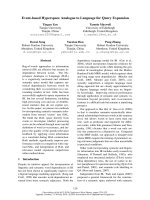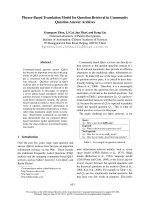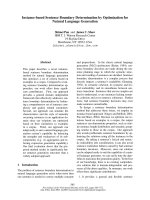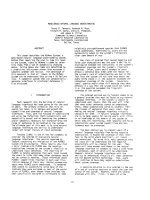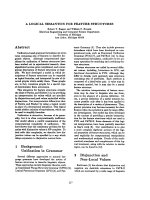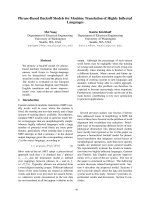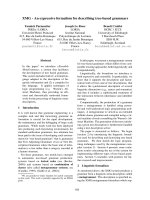Báo cáo khoa học: "Principle Based Semantics for HPSG" pptx
Bạn đang xem bản rút gọn của tài liệu. Xem và tải ngay bản đầy đủ của tài liệu tại đây (899.61 KB, 8 trang )
Principle Based Semantics for HPSG
Anette Frank and Uwe Reyle
Institute for Computational Linguistics
University of Stuttgart
Azenbergstr.12, D-70174 Stuttgart, Germany
e-mail:
Abstract
The paper presents a constraint based semantic
formalism for HPSG. The syntax-semantics inter-
face directly implements syntactic conditions on
quantifier scoping and distributivity. 1 The con-
struction of semantic representations is guided" by
general principles governing the interaction bet-
ween syntax and semantics. Each of these princip-
les acts as a constraint to narrow down the set
of possible interpretations of a sentence. Meanings
of ambiguous sentences are represented by single
partial representations (so-called U(nderspecified)
D(iscourse) R(epresentation) S(tructure)s) to which
further constraints can be added monotonically to
gain more information about the content of a sent-
ence. There is no need to build up a large number
of alternative representations of the sentence which
are then filtered by subsequent discourse and world
knowledge. The advantage of UDRSs is not only that
they allow for monotonic incremental interpretation
but also that they are equipped with truth condi-
tions and a proof theory that allows for inferences
to be drawn directly on structures where quantifier
scope is not resolved.
1 Introduction
The semantic analysis of standard HPSG deviates
from the familiar Montegovian way to construct se-
mantic representations mainly in that it uses unifica-
tion to eliminate the need for 13-reduction. Variables
1In the present paper we do only focus on simple
principles restricting scope ambiguities and ambiguities
resulting from plural NPs in English. For German re-
strictions on scope are much more complicated
because
they cannot be stated independently of scrambling phe-
nomena. In (l~-ank/Reyle 1994) the present approach is
worked out for a fragment of German that deals with
(i) quantifier scope ambiguities triggered by scrambling
and/or movement and (ii) ambiguities that arise from
the collective/distributive distinction of plural NPs. The
underlying scope theory for German was developed in
(Frey 1993). The analysis in (Frank/Reyle 1994) departs
significantly from our earlier account in (Frank/Reyle
1992), where monotonicity was not ensured.
9
are
bound to argument positions by the close inter-
play between syntactic and semantic processing; and
the semantics of constituents is determined by the
Semantics Principle, which governs the way of unify-
ing the semantics of daughter constituents to build
up the semantic value of the phrasal constituent:
The CONTENT value is projected from the
seman-
tic head,
which is defined as the syntactic HEAD-
DTR in head-comp-structures, but as the ADJ-DTR
in head-adjunct structures. It is important to note
that the semantic contribution of quantified verb ar-
guments is not completely projected as part of the
CONTENT value. The meaning of such NPs splits
into the features QUANTS, a list representing the
information about quantifier scope, and NUCLEUS,
containing the nonquantificational core. In the ge-
neral case only the NUCLEUS is projected from the
semantic head according to the Semantics Principle,
while the QUANTS value gets instantiated stepwisc
in interaction with the quantifier storage mechanism
(Cooper Store). The mechanism of Cooper storage
is built into HPSG by use of two further attributes,
QSTORE and RETRIEVED, both represented as sets
of quantifiers. All quantifiers start out in QSTORE
by lexical definition. The Semantics Principle defines
the inheritance of QSTORE to the phrasal constitu-
ents, where they may be taken out of store by an
appropriately instantiated RETRIEVED value and
then put into the QUANTS value of the CONTENT
feature. The order in which the semantic value of
quantified NPs is retrieved fixes their relative scope.
To analyse sentences with scope ambiguities several
parses are thus necessary. Besides the definition of
appropriate restrictions to and configurations for ap-
plications of RETRIEVED the main problem we face
with this kind of analysis is to modify the semantics
of HPSG in such a way that it yields underspecificd
representations and not sets of fully specified ones.
Further shortcomings of HPSG semantics are the fol-
lowing. First, adjuncts (like quantificationai adverbs,
modals) and also negation bear the potential to in-
troduce scope ambiguities. In order to treat them
by the same mechanism that treats the arguments
of the verb their meaning representation would ha-
ve to be put into store. This, however, requires fur-
ther modifications of the Semantics Principle, bec-
ause the treatment of head-adjunct structures differs
essentially from the treatment of other configurati-
ons (see (Pollard/Sag 1994), Ch.8). 2 Second, the-
re is no underspecified representation of ambiguities
that arise from the distributive/collective distinction
of plural NPs (neither within the'HPSG framework
nor in the C(ore)L(anguage)E(ngine)3). Third, the
semantic representation of indefinite NPs must be
independent of the context in which they are in-
terpreted. We do not want to switch from a uni-
versally quantified interpretation to an existentially
quantified one, when we come to disambiguate the
ambiguous sentence Every student who admires
a philosopher reads his original writings such
that a philosopher is interpreted specifically. This
requirement calls for DRT as underlying semantic
formalism.
In the sequel of this paper we show how the extensi-
on of DRT to UDRT developed in (Reyle 1993) can
be combined with an HPSG-style grammar. The ba-
sic idea of the combination being that syntax as well
as semantics provide structures of equal right; that
the principles internal to the syntactic and seman-
tic level are motivated only by the syntactic and se-
mantic theory, respectively; and that mutually cons-
training relations between syntax and semantics are
governed by a separate set of principles that rela-
te syntactic and semantic information appropriately.
We will replace the Semantics Principle of standard
HPSG versions by a principle which directly reflects
the monotonicity underlying the interpretation pro-
cess designed in (Reyle 1993): At any stage of the
derivation more details are added to the description
of the semantic relations between the various com-
ponents of the sentence, i.e. the partial representa-
tion of any mother node is the union of the parti-
al representations of its daughter nodes plus further
constraints derived from the syntactic, semantic and
also pragmatic context.
2
Quantifier Scope and Partial Orders
The need for underspecified representations is by
now widely accepted within computational and theo-
retical linguistics. 4 To make the results of the
ongoing research on underspecified representations
available for HPSG we may pursue two strategies.
According to the first strategy we take the HPSG-
style analysis - essentially as it is - and only ap-
2For general criticism of the analysis of adjuncts in
standard HPSG see (Abb/Maienborn 1994). Their ana-
lysis of adjuncts in HPSG fits neatly into the account of
semantics projection to be presented below.
3See (Alshawi 1992). In CLE the:resolution of QLFs
also involves disambiguation with respect to this kind of
ambiguities.
4See (Peters/vanDeemter 1995) for recent discussion.
ply slight modifications to produce underspecified
output. The second strategy involves a more radical
change as it takes an existing theory of underspeci-
fled representations and replaces the HPSG seman-
tics by the construction principles of this theory.
Let us start out with a sketch of the first approach.
It will show us where its limitations are and allow
us to compare different approaches to underspeci-
fication. The first thing to do, when un-specifying
HPSG semantics, is to relax the retrieval operati-
on. This must be done in two respects. First, we
must allow NP-meanings not to be retrieved at all.
This results in their relative scope not being deter-
mined. Second, we must accommodate syntactic and
semantic restrictions on possible scope relations to
be stated by the grammar. 5 Restrictions specifying,
for example, that the subject NP must always have
wide scope over the other arguments of the verb; or,
that the scope of genuinely quantified NPs is clause
bounded. The modifications we propose are the fol-
lowing. First, we incorporate the QSTORE feature
into the CONTENT feature structure. This makes
the NP meanings available even if they are not re-
trieved from QSTORE. Second, we take the value of
the QUANTS feature not to be a "stack" (i.e. by ap-
pending new retrieved quantifiers as first elements
to QUANTS), but allow any NP meaning that is re-
trieved at a later stage to be inserted at any place
in that list. This means that the order of NP mea-
nings in QUANTS fixes the relative scope of these
meanings only; it does not imply that they have
narrow scope with respect to the NP meaning that
will be retrieved next. But this is not yet enough
to implement clause boundedness. The easiest way
to formulate this restriction is to prohibit projection
of quantified NP meanings across bounding nodes.
Thus the QSTORE and QUANTS values of a boun-
ding node inherit the quantificational information
only of indefinite NPs and not of generalized quan-
tifiers. To be more precise, let us consider the tree
/3 consisting only of the bounding nodes in the syn-
tactic analysis of a sentence 3". Then the semantic
content of ~ can be associated with nodes of ~ in
the following way. For each node i of fl the attribu-
tes QUANTS, QSTORE and NUCLEUS have values
quantsi, qstorei and nucleusi. The relative scope
between scope bearing phrases of ~, i.e. between the
elements of Ui(quantsiUqstorei) can then be defined
as follows.
• If Q1 and Q2 are in quantsi and Q1 precedes
Q2, then Q1 has scope over Q2.
• If Qa is in quantsi and Q2 in quantsj, where i
dominates j, then Q1 has scope over Q2.
• If Q1 is in qstorei and not in qstorej, whe-
re i dominates j, then Qa has scope over
any Q2 in qstorejUquantsj that are not in
qstoreiUquantsi.
5This has to be done also for the standard theory.
10
Tim last clause says that any NP Q1 occurring in
the clause of level i and that is still in QSTORE
has scope over all quantified NPs Q2 occurring in
embedded clauses (i.e. clauses of level j). But Q1
does not necessarily have scope over any indefinite
NP introduced at level j.
Those familiar with the work of Alshawi and Crouch
(Alshawi/Crouch 1992) might have noticed the simi-
larity of their interpretation mechanism and what
we have achieved by our modifications to standard
HPSG semantics. The elements of QUANTS play ex-
actly the same role as the instantiated metavariables
of Alshawi and Crouch. This means that we could
adapt their interpretation mechahism to our parti-
ally scoped CONTENT structures. But note that we
already have achieved more than they have as we are
able to express the clause-boundeness restriction for
generalized quantifiers.
We will not go into the details and show how the
truth conditions of Alshawi and Crouch have to be
modified in order to apply to partially scoped CON-
TENT structures. We will instead go ahead and work
out the limitations of what we called the first stra-
tegy. To keep things as easy as possible we restrict
ourselves to the case of simple sentences (i.e. to. tri-
vial tree structures of QSTORE and QUANTS va-
lues that consist of one single node only). In this
case the QUANTS value (as well as the instantiati-
on of metavariables) imposes a partial order on the
relative scope of quantifiers. Assume we had a sent-
ence with three quantifiers, Q1, Q2 and Q3. Then
the possible lenghts of QUANTS values varies from
0 to 3. Lengths 0 and 1 leave the relative scope of
Q1, Q2 and Q3 completely underspecified. Values of
length 2 say that their first element always has wi-
de scope over the second, leaving all possible choices
for the third quantifier. And finally we have the fully
specified scoping relations given by values of length
3. There are, however, some possibilities to restrict
scope relationships that cannot be represented this
way: One cannot, for example, represent the ambi-
guity that remains if we (or, syntax and semantics)
require that Q1 and Q2 must have scope over Q3,
but leaves unspecified the relative scope between Q1
and Q2; nor are we able to express a restriction that
says Q1 must have scope over both, Q2 and Q3, while
leaving the relative scope between Q2 and Q3 un-
specified. Retrieving a quantifier Qi (or starting to
calculate the truth value of a sentence by first consi-
dering this quantifier) is an operation that takes Qi
and adds it to QUANTS. As QUANTS is a list this
amounts to a full specification of the relative scope
of Qi with respect to
all
other elements already con-
tained in QUANTS. This shows that the expressive
power of the representation language is too restricti-
ve already for simple sentences. We need to represent
partial
orders of quantifier scope. But we cannot do
this by talking about a pair consisting of a quanti-
fier Qi and a list of quantifiers QUANTS. We must
be able to talk about
pairs o] quantifiers.
This not
only increases the expressive power of the represen-
tation language, it also allows for the formulation of
restrictions on quantifier scope in a declarative
and
natural way. The formalism of UDRSs we introduce
in the following section is particularly suited to 'talk'
about semantic information contributed by diffcrent
components of a sentence. It therefore provides a
particularly good ground to implement a principle
based construction of semantic representations.
3 UDRS Construction in HPSG
In the following we will design a syntax-semantics in-
terface for the construction of UDRSes in HPSG, fo-
cussing on the underspecified representation of scope
and plural. To overcome the problems discussed in
Section 2 we chose to depart from the semantics
used in standard HPSG (Pollard/Sag 1994), and in-
stead allow for the construction of (U)DRScs. The
structure of the CONTENT attribute as well as the
Semantics Principle will be changed substantially,
since the construction of (U)DRSes allows for inher-
ently different information structures and processing
mechanisms. The former CONTENT attribute is re-
placed by a complex feature structure UDRS, consi-
sting of three attributes, LS, SUBORD and CONDS.
I
F~s
[L-MAX
I, ~]
]
(1) / uDRs/susoar) {l < 1' }|
L g ¢°~Ds
{",
} J
CONDS is a set of labelled DRS-conditions, ~i, the
form of which is determined by lexical entries. SUB-
ORD contains information about the hierarchical
structure of a DRS. It is expressed by means of a
subordination relation, <, between labels. If ")'1 and
"72 are two DRS-conditions with labels ll and 12 such
that ll <_ 12 is contained in SUBORD, then this is
equivalent to saying that ~/1 and ")'2 will occur in
DRSs/(1 and/(2 such that/(1 is weakly subordina-
te to/(2, i.e. /(1 is either identical to
I(2
or nested
within it. SUBORD thus imposes the structure of an
upper semi-lattice with one-element, lT, to the set
of labels. The attribute LS defines the distinguished
labels, which indicate the upper and lower bounds
for a DRS-condition within the semilattice.
The main task in constructing UDRSes consists
in appropriately relating the labels of the DRS-
conditions that are to be combined. This is perfor-
med by the association of DRS-conditions with di-
stinguished labels in the lexical entries on the one
hand and by conditions governing the projection of
the distinguished labels on the other. The role of the
distinguished labels is most transparent with verbs
and quantifiers.
In the lexical entry of a transitive verb, for example,
the DRS-condition stated in CONDS is a relation
11
holding between discourse referents. 6 This condition
is associated with an identifying label 1. In addition
1 is identified as the minimal distinguished label of
the verbal projection by coindexation with L-MIN.
rcAsE 1 rOASEo ol 1
OAT,HISC< [D"EFm
]'[O.EP[]]
>
r,+[,-+ l
(2)
/ SUBOrtD
{}
/
[
uo~s / f
[LABEL Iml
]/
REL hire
/H
L t L ARo2 [] J JJ
Generalized quantifiers, as in (3), introduce two new
labels which identify the DRS-conditions of their re-
stricter and nuclear scope. The quantificational re-
lation holding between them is stated in terms of
the relation attribute, REL. In the lexical entry for
every,
given in (3), a new discourse referent is intro-
duced, in the restrictor DRS, labelled 111, which is
identified with the label of the subcategorized NP.
The feature SUBORD defines the labels of restrictor
and scope to be subordinate to the label 11 which
identifies the entire condition. The label 11 is defi-
ned as the upper bound, or distinguished maximal
label of the quantificational structure, whereas the
lower bound, or distinguished minimal label is given
by the label of the nuclear scope,
112.
• [HEAD
quant
l
P
EL-MAX
[Eql
/LS
(3)
I suB°R~ {E]>~[I]95]. >~q}
UDRS / r
rLABEL l~
l
l
_.
/
IREL ever~
/
[LABEL
iT~Tll(
/ / b Es
:
Jf
L
t
LSCOPE ll[~JJ )
The entry for the indefinite singular determiner, (4),
introduces a new individual type referent. As inde-
finites do not introduce any hierarchical structure
into a DRS the identity statement 11 = 112 for the
minimal and maximal labels is defined in SUBORD.
r rHEAOrAo' .,N'.'M ]'11
<+/
1
/,-,o.s/s o'~a
{DIF~[TS]} :I
D
LABEL []
"
L L
]}J
The construction of UDRSes will be defined in terms
of clauses of the Semantics Principle: In (5), clau-
se (I) of the Semantics Principle defines the inhe-
ritance of the partial DRSes defined in the CONDS
attributes of the daughters to the CONDS value of
the phrase. Contrary to the Semantics Principle of
(Pollard/Sag 1994) the semantic conditions are al-
ways inherited from
both
daughters (we assume bi-
°The reference to discourse referents of the syntactic
arguments is only provisionally stated here. For the pre-
cise definition see (10) below. The use of SUBCAT (SC)
as a head attribute is motivated in (Frank 1994).
nary branching) and therefore project to the upper-
most sentential level. Furthermore, clause (I) app-
lies to
head-comp-
and
head-adj-structures
in exactly
the same way. 7 Clause (II) of the Semantics Princi-
ple defines the inheritance of subordination restric-
tions: The subordination restrictions of the phrase
are defined by the union of the SUBORD values of
the daughters. Clause (Ill) of the Semantics Princi-
ple states the distinguished labels LS of the phrase to
be identical to the distinguished labels of the HEAD-
daughter. It is therefore guaranteed that in binary
branching structures the minimal and maximal la-
bels of the head category are available all along the
(extended) head projection, s This prepares clauses
(IV) and (V) of the Semantics Principle, which de-
fine the binding of discourse markers and locality
of quantificational scope, respectively. We will first
consider clause (IV) and will come back to clause
(V) in the next Section.
In a (U)DRS, the partial structure of the verb has
to be (weakly) subordinate to the scope of all the
partial DRSes that introduce the discourse markers
corresponding to the verb's arguments. This gua-
rantees that all occurrences of discourse markers are
properly bound by some superordinated DRS. The
constraint is realized by clause (IV) of the Semantics
Principle, the Closed Formula Principle. It guaran-
tees that the label associated with the verb, which is
identified with the distinguished minimal label of the
sentential projection, is subordinated to the minimal
label, or lower bound of each of the verb's arguments.
Note that with quantified arguments the predicate
of the verb must be subordinate to the nuclear scope
of the quantifier. As defined in (3), it is in fact the
nuclear scope of the quantified structure that will
be accessed by the distinguished minimal label of
the quantified NP. Thus the Closed Formula Princi-
ple (IV) in (5) states that in every (non-functional)
head-comp-struc
a further subordination restriction
is unioned to the phrase's SUBORD value, which
subordinates the minimal label of the head -here the
minimal label associated with the verb- to the mini-
mal label of its actual complement, which in case of
a quantified argument identifies the nuclear scope.
Semantics Principle: 9
" rLS [] ]1
UDRS [SUBORD.,
U { ~ > ~} U[~] U[~]
JJ
LCONDS []
uI-fl
.head-comp-st.ruc
H-DTR.
(5) o-D+R
~~
UDRS |SUBORD [] N UDRS |SUBOaD []
LOONDS [] JJ Loo~s []
~See (Abb/Malenborn 1994) for a corresponding ana-
lysis of adjuncts.
SFunctional categories inherit the distinguished labels
of their complement (see (7)). The distinguished labels
therefore project along the
extended
head projection.
12
I Inheritance of UDRS-Conditions
II Inheritance of subordination restrictions l°
III Projection of the distinguished labels
IV Closed Formula Principle
Note that generalized quantifiers were marked as
scope bearing by non-identical values of minimal and
maximal labels; and singular indefinite NPs were
marked as not scope bearing by identifying minimal
and maximal labels. As plural NPs introduce a quan-
tificational condition when they are interpreted dis-
tributively but behave like indefinites when interpre-
ted collectively, in a representation of their meaning
that is underspecified with respect to the distribu-
tive/collective ambiguity plural NPs must be mar-
ked as potentially scope bearing. This can be achie-
ved if in the lexicon entry of a plural determiner
(6) we do not completely specify the relation bet-
ween the minimal label 112 and the maximal label
l~, but only require that 112 is weakly subordinate to
11. This weak subordination relation will be further
restricted to either identity or strict subordination
when more information is available from the seman-
tic or pragmatic context that allows the ambiguity to
be resolved. By monotonically adding further cons-
traints a collective or quantificational (distributive
or generic) reading of the plural NP may then be
specified, xl If a distributive reading is chosen, the
minimal label 112 will identify the nuclear scope of
the quantified structure, and in the case of a coll-
ective reading the relation of (weak) subordination
between minimal and maximal label will be reduced
to identity. We will state this in detail in Section 4.
F rHEAD rAGB.] NUM
pl] ] q
/°AT
CL"BEL >l /
/ r -I/
/,~,~s/s, 'BORD CD]]_>ri;T]~. //
ND
LABEL [-~
L Loo s ]}JJ
Together with the structure of the lexical entries illu-
strated above, the clauses (I) - (IV) of the Semantics
Principle given in (5) define the core mechanism for
UDRS construction: The Semantics Principle defines
the inheritance of the labelled DRS conditions and of
the subordination restrictions between these labels,
which define the semilattice for the complete UDRS
structure. The subordination restrictions are projec-
ted from the lexicon or get introdhced monotonical-
9The Semantics Principle will only be given for head-
comp-structures. For head-subj- and head-adj-structures
corresponding clauses have to be stated. For head-filler-
structures we only define inheritance of CONDS, SUB-
ORD, and LS from the HEAD-DTR.
lOThe dots indicate that further subordination restric-
tions will be unioned to the phrase's SUBORD value by
clause (V) of the Semantics Principle, defined below.
llXVe are not in the position to discuss the factors that
determine these constraints here.
ly, e.g. by the Closed Formula Principle to ensure
the correct binding of discourse referents. Further
subordination restrictions will be added - monoto-
nically - by the remaining clauses of the Semantics
Principle, to be introduced in the next Section.
4
Quantifier Scope and Plural
Disambiguation
Quantificational Scope Since the conditions on
quantificational scope for generalized quantifiers and
distributive readings of plural NPs are dependent on
syntactic structure, the Semantics Principle will be
supplemented by further clauses governing the in-
terface between syntactic constraints and semantic
representation. Note that genuine quantifiers as well
as distributive readings of plural NPs differ in their
scope potential from indefinite NPs and collectivcly
interpreted plural NPs. Whereas the latter may take
arbitrarily wide scope, the scope of the former is
clause bounded, i.e. they are allowed to take scope
only over elements that appear in their local domain.
We implement this restriction by requiring that the
maximal label of a generalized quantifier be subor-
dinate to the distinguished label that identifies the
upper bound of the local domain. For plural NPs, a
similar constraint must be stated in case a distribu-
tive reading is chosen which specifies the plural NP
as scope bearing.
The distinction between scope bearing and not scope
bearing NPs was defined by strict subordination and
identity of the distinguished labels, respectively. In
case a distributive reading is chosen by the clauses
for plural disambiguation, to be stated below, the re-
lation of weak subordination in (6), is strengthened
to strict subordination. Yet, plural disambiguation
may take place rather late in subsequent discourse,
while the syntactic constraints for quantificational
scope can only be determined locally. The Quanti-
tier Scope Principle (V) will therefore introduce con-
ditionalized subordination restrictions to define the
clause-boundedness of both generalized quantifiers
and distributively quantified plural NPs. ~2
For finite sentences the local domain for quantified
verb arguments comes down to the local IP projec-
tion (Frey 1993). In a functional HPSG grammar
(see (Frank 1994)) this local domain corresponds to
the functional projection of the finite VP. The di-
stinguished maximal label lmax which identifies the
upper bound of the local domain for quantified vcrb
arguments will therefore be instantiated by the com-
plementizer heading a finite sentence, as in (7).
X2The scoping principles described in (Frank/lleyle
1994) further account for the scope restrictions of ge-
neralized quantifiers and distributive plural NPs.
13
Due to the projection of the distinguished labels by
clause (III) of the Semantics Principle and the de-
finition of functional categories, the upper bound
for the local domain of quantifier scope,
lma~,
is
available throughout the extended projection, where
clause (V) of the Semantics Principle, the Quanti-
fier Scope Principle, applies. In (8), the Quantifier
Scope Principle (V) states that if the complement is
a generalized quantifier (type
quant)
or a
potentially
scope bearing
plural NP (type
plura 0
the SUBORD
value of the phrase will contain a further
conditiona-
lized
subordination constraint, which states that - if
the argument is, or will be characterized as a
scope
bearing
argument by strict subordination of its mini-
mal and maximal label - the complement's maximal
label lq~,a,u is subordinate to the label
lmax
which
identifies the upper bound of the local domain.
Semantics Principle:
Clauses I - IV &: V Quantifier Scope Principle
-o ]]
.D~S
/ s~B°~D q~> ~ ~ ~
-> [~
.head-cornp strue
(S) e-~r~
CAT J HEAD quant V plural "]
LS LS L-MIN
UDR.S L-MIN
]
]SUBORD ~
|J /SU'BORD [] /
L LCONDS
[] ]j cc6~ns [] J
Underspecified Representations for Plural
We argued that for an underspecified representation
of plural NPs as regards the collective/distributive
ambiguity, their meaning has to be represented by
potentially scope bearing
partial DRSs. This was
achieved by stating the minimal label of the plural
NP to be
weakly subordinated
to its maximal label
in (6). Yet, in order to allow for an underspecified
representation of the example given in (9), the lexi-
cal entry of the verb, stated in (2), has to be refined
as indicated in (10).
(9) The lawyers hired a secretary.
CASE
nora
CASE
ace
[CATIHISC< [UDP,3[~] ]'[UDRS~]] >
/
Vs
1
(10)
/ / SUBORD
{}
/
/UDaS /
ffLABEL rn
1/1
/
,m.oond,,l |
L L I, LARO2
drey_res(121,
Cond2)J)J
Note that as long as it is not determined whether a
distributive or collective reading will be chosen for
the plural NP, the discourse referent which occupies
the corresponding argument place of the verb can-
not be identified with the group referent introduced
by the plural NP
the lawyers.
Instead, the mapping
between NP meanings and the corresponding argu-
ment slots of the verb will be defined by a function
dre]_res,
which returns the value of the appropriate
discourse referent once a particular plural interpre-
tation is chosen for (9).
But as long as the plural ambiguity is unresolved the
function
dre]_res
will be undefined. Thus, if context
does not provide us with further, disambiguating in-
formation, (11) will be the final, underspecified re-
presentation for (9). Here, the function
dref_res
is
undefined for the (underspeeified) plural subject NP.
i-suB {,~ ~ I~].'~ -> ~.IKI >- I~:t,l~ > I~,IKI ~}-I
J
|CONDS ,~ I REL U~,,,~,'H, I REL ~ec~. I '
illS/ I.
I
DR.EF X J LDR.EF y J
' '/ VABEL[N 1/
/ I
aEL
hire
/
l I
AROI
dref-res(UDItSl,
CondD]
L
LARO2 y J
Note that the requirement for an underspecified re-
presentation of the discourse referent to fill the argu-
ment place of the verb cannot be implemented by use
of a type hierarchy or similar devices which come to
mind straightforwardly. For it is not appropriate for
the issue of underspecified representations to compu-
te the set of disjunctive readings, which would ensue
automatically if we took such an approach. Instead,
the function
dre/_res
will be implemented by using
delaying techniques. The conditions which determi-
ne the delayed evaluation of the function
dre/_res
are
defined in its second argument
Cond.
As long as the
variable
Cond
is not instantiated, the evaluation of
~dref_res
will be blocked, i.e.
delayed. 13
The three clauses of the function
dref_res
in (12)
and (13) distinguish between
not scope bearing, scope
bearing
and
potentially scope bearing elements.
co.os
[]
L
{[
}J
(12)
,,
l
The first clause of (12), which takes as its first argu-
ment the UDRS value of a verb argument, as defined
in (10), is only appropriate for non-quantificational
singular NPs (4). The SUBORD value pertaining to
the argument is constrained to contain a conditi-
on which identifies its minimal and maximal labels:
11 = In. The second clause applies if the semantic
structure of the argument contains a subordination
restriction which characterizes the NP as
scope bea-
ring.
This is the case for generalized quantifiers (3).
The values of the minimal and maximal labels are
lain the CUF system (Doerre/Dorna 1993) delay
statements are defined by the predicate
wait.
The delay-
ed function can only be evaluated when all specified ar-
gument positions are instantiated. The delay statement
for
dref_res
is
wait(dref_res(udrs, subord_info)),
where
subord_info
is the type of a member of SUBOILD.
14
characterized as non-identical by strong subordina-
tion: 11 > 112.
If a clause is applied successfully, by coindexation
of the differentiating subordination restrictions with
the second argument of
dre]_res,
the latter gets pro-
perly instantiated and the function is relieved from
its delayed status. It returns the discourse referent
which in the argument's UDRS is associated with the
maximal label for
not scope bearing
NPs, and with
the label of the restrictor 111 for
scope bearing
NPs.
For plural NPs, which are represented as
potential-
ly scope bearing
by a weak subordination constraint
as shown in (6), the clauses in (12) will fail: the re-
quired subordination conditions will not be contai-
ned in the SUBORD value of the verb argument. 14
Underspecified as well as disambiguated plural NPs,
characterized by a
weak
subordination constraint in
the local UDRS, are captured by the third clause of
dre/_res
in (13).
(13) ~rer-~es ]
s L~_~,~
.c
LSUBOaD{ l[~ > [i~
In (13) the value of
dre/_res
is undefined (T) and the
variable
Cond,
which is subject to the delay conditi-
ons on
dref_res,
is not instantiated by coindexation
with a subordination restriction in the local SUB-
ORD value. The function therefore is delayed, un-
til further disambiguating constraints are available
which resolve the plural ambiguity and determine
the discourse referent to fill the argument slot of the
verb. This is what we aimed at for the special con-
cerns of plural underspecification.
If, however, a particular reading of a plural NP is
determined by the lexical meaning of the verb, as it
is the case for
gather,
an appropriate definition of
dref_res
in the lexical entry of the verb ensures the
correct plural interpretation.
Plural Disamblguation In most cases, however,
disambiguating information for the interpretation of
plurals comes from various sources of semantic or
pragmatic knowledge. Usually it is provided by sub-
sequent discourse. We therefore define a mechanism
for plural disambiguation which may apply at
any
stage of the derivation, to add disambiguating DRS
conditions and subordination constraints to the un-
derspecified representation whenever enough infor-
mation is available to determine a particular plural
interpretation. To this end we extend the Semantics
14This will be so even if - by the function
pl_dis
to be
introduced below - further disambiguating constraints
for, e.g., a collective or distributive reading are introdu-
ced at a later stage of the derivation:
dref_res
is defined
on the UDRS value of a verb argument in the lexical
entry of the verb. The value of thfs local UDRS, and
with it the SUBORD attribute, remains unaffected by
the introduction of additional subordination restrict.ions
by clauses of the Semantics Principle.
Principle to include a function
pidis (plural disam-
biguation),
which applies to a phrase's UDRS value,
to render a new value of the same type, which spe-
cifies a collective or distributive reading for a plural
discourse referent contained in the underspecified re-
presentation. The individual clauses of
pLdis
will ha-
ve to state constraints for determining the respective
plural readings, to be satisfied by the preceding con-
text, represented in UDRS. Ideally, these constraints
have access to inference modules, including semantic
and pragmatic knowledge. We first state the function
pidis
for the different readings and then incorporate
the function into the Semantics Principle.
If in clause (14) of
pLdis
the constraints that deter-
mine a collective reading of the plural NP with label
11 are satisfied, the relation of weak subordination
between the minimal and maximal label of the plu-
ral NP is strenghtened to the identity relation. In
tile
output value the restriction 11 = In gets unioned to
the original SUBORD value. Note that the function
pidis
is fully monotonic in that its result is a UDRS
which is obtained by only
adding
information to the
input values SUBORD and CONDS by union.
Whenever disambiguation of a plural NP takes
place, the function
dref_res
must be relieved from its
delayed status in order to instantiate the correspon-
ding argument slot of the verb. We will access the
delayed goal
dref_res
by reference to the plural NP's
maximal and minimal labels 11 and 112, instantiate
its second argument by the identity constraint 11 =
112, and define its value by the DREF value X asso-
ciated with 11. The resulting UDRS for a collective
interpretation of (9) is given in (15).
rSUBORD [] { ",El] > [Vj1 }
pt-dls CONDS LABEL :=
L []
[Lsra
~]
(14)
/s~o~ [] o
(~
[rm = rrrrl]
LCONDS []
Conditions:
constraints for a collective
reading (of X) &:
L L-MIN I II.L~IJ J
SUBORD {
|T
>
IT
> >
r _Era. _1~.1~ _l-Wl.l-rC] -ITTI.1
/ I-rrrl _>q2H.rrCl ~ /
(15)| I' r~,~m7 1 r~,~l r~*~,,~l ] /
C
ND E t-~ ~ REL hire
L JLDR'EFEI JJJ
Disambiguation to a distributive reading is obtained
in (16) by adding a quantificational distribution con-
dition to the original value of CONDS. The restrictor
In introduces an individual discourse referent x to-
gether with the distribution condition x 6 X and
the nuclear scope is identified by the minimal label
112. Moreover, (strong) subordination of restrictor
and scope is defined in SUBORD. Again, the delayed
function
dref_res
is defined to return the discourse
referent x which is to fill the argument slot of the
15
verb and is un-delayed by instantiation of its second
argument.
LS []
([SUBORD[~] { [h']>[~ } ]~
pl-dls LA - ~'="' :=
t L oNo [] { }j)
}}
[s ,.o <o im > Elm >
(16) I
(
FLAB~-L[~ I FLABI~L il[~klJ -]
Conditions:
constraints for a distributive reading (of X) ~
<,.,:,.o<,_:o:,: <,, ,_ :(
\Ve now complete the Semantics Principle by the
Principle for Plural Disambiguation (VI). In (17),
the function pl_dis applies in a coordination struc-
ture coord-struc, which recursively, combines pairs of
(sequences of) sentences and a sentence. The func-
tion pl_dis applies to the phrase's UDRS value, which
is defined by application of the basic clauses (I) and
(II) of UDRS construction. Depending on the con-
text represented in UDRS, and supplemented by ge-
neral semantic and/or pragmatic knowledge, pl_dis
monotonically redefines the phrase's UDRS value if
disambiguating constraints for a specific plural rea-
ding can be determined. If the constraints for plu-
ral disambiguation (14) and (16) are not satisfied,
the trivial clause of pl_dis applies, which returns the
UDRS value of its argument without modifications.
Semantics Principle: Clauses I, II and VI
[:.:7::,:,2,: ( m , ,•1
(17) COOR~O-OTR
[CONDS [] JJ [CONDS [] JJ
5 Conclusion and
Perspectives
A constraint based semantic formalism for HPSG
has been presented to replace the standard HPSG se-
mantics. The new formalism comes closer to a princi-
ple based construction of semantic structure and,
therefore, is more in the spirit of HPSG philosophy
than its standard approach. Furthermore the new
formalism overcomes a number of shortcomings of
the standard approach in a natural way.
In particular, we presented an HPSG grammar for
English that defines a syntax-semantics interface
for the construction of U(nderspecified) D(iscourse)
R(epresentation) S(tructure)s. The construction is
guided by general principles, which clearly identify
the interaction between the modules, i.e. the "inter-
face" between syntax and semantics. In the fragment
we defined underspecificied representations for quan-
tificational structures and plural NPs. The princip-
les governing the interaction of syntax and semantics
specify scoping relations for quantifiers and quanti-
ficational readings of plural NPs.
In addition to the syntax/semantics interface the Se-
mantics Principle developed in this paper defines a
clear interface to contextual and pragmatic knowled-
ge. This interface allows reasoning modules to inter-
act with semantics construction. The approach taken
here can, therefore, be generalized to disambiguation
problems other than the collective/distributive am-
biguity as well as to anaphora resolution. A further
issue to which the present account is directly related
is incremental interpretation.
References
Abb, B./ Malenborn, C. 1994. Adjuncts in HPSG. In:
Trost, H. (ed): KONVENS '94, Springer, Berlin, 13-22.
Alshawi, H. (ed.) 1992. The Core Language Engine, The
MIT Press
Alshawi, H./ Crouch, 1t. 1992. Monotonic Semantic In-
terpretation. In: Proceedings of the 3Oth A CL, University
of Delaware, 32-39.
Cooper, R. 1983. Quantification and Syntactic TheoT"y.
Reidel, Dordrecht, 1-29.
DSrre, J./Dorna, M. 1993. CUF - A Formalism for Lin-
guistic Knowledge Representation. In: DSrre, J. (ed):
Computational Aspects of Constraint-Based Linguistic
Description L ESPRIT Basic Research Action BR-6852
(DYANA-2), Deliverable R1.2.A.
Frank, A. 1994. Verb Second by Underspecification. In:
Trost, H.(ed): KONVENS '94, Springer, Berlin, 121-130.
Frank, A./ Reyle, U. 1992. How to Cope with Scramb-
ling and Scope. In: GSrz, G. (ed.) KONVENS '92. Reihe
Informatik aktuell, Springer, Berlin, 178-187.
Frank, A./Reyle, U. to appear. Principle Based Seman-
tics for HPSG. In: Arbeitspapiere des Sonderforschungs-
bereichs 340, University of Stuttgart.
Frey, W. 1993. Syntaktische Bedingungen fiir die seman-
tische Interpretation, Studia Grammatica Bd. XXXV,
Akademie Verlag, Berlin.
Kamp, H./Reyle, U. 1993. From Discourse to Logic, Rei-
del, Dordrecht.
Peters, S./van Deemter, C.J. (eds.) 1995. Semantic Am-
biguity and Underspecification (tentative title), to appear
in: CSLI Lecture Notes.
Pollard, C. / Sag, I.A. 1994. Head-Driven Phrase Struc-
ture Grammar, Chicago: University of Chicago Press and
Stanford: CSLI Publications.
Reyle, U. 1993. Dealing with Ambiguities by Underspe-
cification: A First Order Calculus for Unscoped Repre-
sentations. In: Proceedings of the Eighth Amsterdam Col-
loquium, Amsterdam.
Reyle, U. 1993. Dealing with Ambiguities by Underspe-
cification: Construction, Representation and Deduction.
In: Jounal of Semantics, 10(2).
Reyle, U. 1994. Monotonic Disambiguation and Plural
Pronoun Resolution. ms. Universit~it Stuttgart, submit-
ted to: Peters, S./van Deemter, C.J. (eds.) (1995).
16
